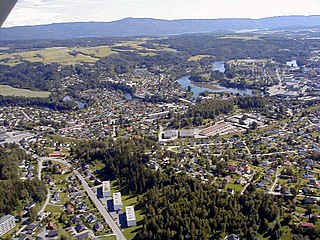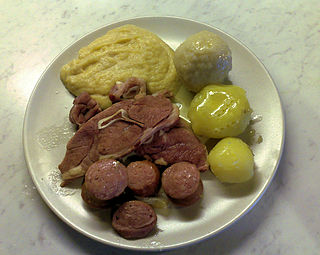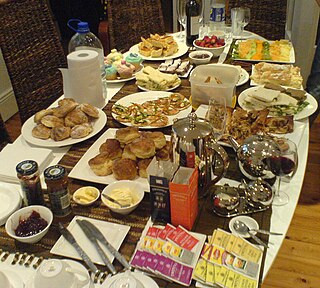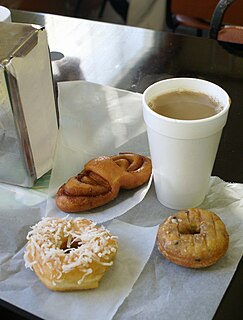Related Research Articles

The potato is a root vegetable native to the Americas, a starchy tuber of the plant Solanum tuberosum, and the plant itself is a perennial in the nightshade family, Solanaceae.

Potato chips, or crisps, are thin slices of potato that have been either deep fried or baked until crunchy. They are commonly served as a snack, side dish, or appetizer. The basic chips are cooked and salted; additional varieties are manufactured using various flavorings and ingredients including herbs, spices, cheeses, other natural flavors, artificial flavors, and additives.

The sweet potato or sweetpotato is a dicotyledonous plant that belongs to the bindweed or morning glory family, Convolvulaceae. Its large, starchy, sweet-tasting, tuberous roots are a root vegetable. The young shoots and leaves are sometimes eaten as greens. The sweet potato is distantly related to the common potato, both being in the order Solanales. The sweet potato, especially the orange variety, is often called a "yam" in parts of North America, but it is entirely unrelated to true yams. Cultivars of the sweet potato have been bred to bear tubers with flesh and skin of many colors, but white, yellow, and orange flesh is common with a darker skin.

Convolvulaceae, known commonly as the bindweed or morning glory family, is a family of about 60 genera and more than 1,650 species of mostly herbaceous vines, but also trees, shrubs and herbs, and also including the sweet potato and a few other food tubers.

Lutefisk is dried whitefish. It is made from aged stockfish, or dried and salted cod, pickled in lye. It is gelatinous in texture after being rehydrated for days prior to eating.

Ringerike is a municipality in the traditional and electoral district Buskerud in Viken county, Norway. It is part of the traditional region of Ringerike. The administrative centre of the municipality is the town of Hønefoss.

Lefse is a traditional soft Norwegian flatbread. It is made with potatoes, flour, butter, and milk or cream. It is cooked on a large, flat griddle. Special tools are used to prepare lefse, including long wooden turning sticks and special rolling pins with deep grooves.

Smalahove is a Western Norwegian traditional dish made from a sheep's head, originally eaten before Christmas. The name of the dish comes from the combination of the Norwegian words hove and smale. Hove is a dialectal form of hovud, meaning "head", and smale is a word for sheep, so smalahove literally means "sheep head". The skin and fleece of the head are torched, the brain removed, and the head is salted, sometimes smoked, and dried. The head is boiled or steamed for about three hours, and served with mashed rutabaga and potatoes. It is also traditionally served with Akvavit. In some preparations, the brain is cooked inside the skull and then eaten with a spoon or fried. Originally, smalahove was typically eaten by the poor.
1. divisjon or OBOS-ligaen is the second-highest level of the Norwegian football league system. Each year, the top finishing teams in the 1. divisjon are promoted to the Eliteserien, and the lowest finishing teams are relegated to 2. divisjon.
Norwegian cuisine in its traditional form is based largely on the raw materials readily available in Norway and its mountains, wilderness, and coast. It differs in many respects from continental cuisine through the stronger focus on game and fish. Many of the traditional dishes are the result of using conserved materials, necessary because of the long winters.
Coop Norge SA is a Norwegian cooperative. It is owned by 117 local cooperatives with more than 1.3 million members. The company has its headquarters in Oslo.
The agricultural cooperatives in Norway consists of 13 companies, each organised as independent farmer owned cooperatives. They cover four different areas for the farmers: refining and sale of produce, financial services, breeding and insemination, and retail of agricultural equipment. All the cooperatives cooperate through the company Norsk Landbrukssamvirke. In total the companies have a revenue of NOK 58 billion and have 18,000 employees. TINE and Nortura are each responsible for about a quarter of the revenue each. Though none of the cooperatives hold any monopolies, their dominant position periodical causes debate about the structure of the agricultural processing industry.

HOFF SA is a Norwegian agricultural cooperative processing and distributing potato produce. The company is owned by 4,000 farmers and has plants in Inderøy, Gjøvik, Brumunddal, and Klepp. The company processes one third of the potato production in the country.

Potetball is a traditional Norwegian potato dumpling. A similar German dish is called Kartoffelklöße.
Edvard Grimstad was a Norwegian farmer and politician for the Centre Party.

Smörgåsbord is a type of Scandinavian meal, originating in Sweden, served buffet-style with multiple hot and cold dishes of various foods on a table.

Agriculture in Cyprus constituted the backbone of its economy when it achieved its independence in 1960. It mostly consisted of small farms, and sometimes even subsistence farms. During the 1960s, irrigation projects made possible vegetable and fruit exports; increasingly commercialized farming was able to meet the demands for meat, dairy products, and wine from the British and United Nations troops stationed on the island and from the growing number of tourists.
Maarud AS is a Norwegian manufacturer of snack foods.

The potato doughnut, sometimes called a Spudnut, is a doughnut, typically sweet, made with either mashed potatoes or potato starch instead of flour, the most common ingredient used for doughnut dough. Potato doughnuts tend to be lighter than all-flour doughnuts, and are prepared in a similar way as other doughnuts. A chain of Spudnut Shops was established across the United States in the 1950s before declining to a few dozen more recently. Fried ube dough is also eaten in East Asia, including the world's most expensive doughnut, the Golden Cristal Ube, which cost $100 each. Much like flour doughnuts, potato doughnuts are often eaten with coffee.

Banas Dairy (Banaskantha District Cooperative Milk Federation, Palanpur) is a dairy based in the Banaskantha district of Gujarat, India and is Asia's largest milk producer. It was founded in 1969, in accordance with the 1961 rule of the National Dairy Development Board under Operation Flood. Galbabhai Nanjibhai Patel played an important role in the foundation of the dairy. It is headquartered at Palanpur.
References
- 1 2 "A.L Gartnerhallen". Store norske leksikon (in Norwegian). Oslo: Kunnskapsforlaget. Retrieved 24 November 2009.
- ↑ "Historikk" (in Norwegian). Garternhallen. Archived from the original on 17 May 2009. Retrieved 24 November 2009.